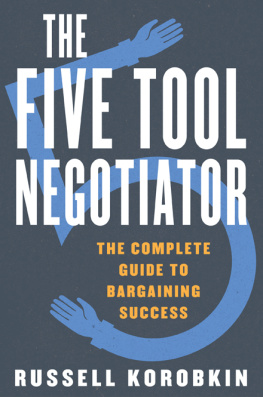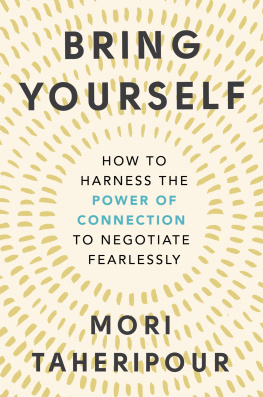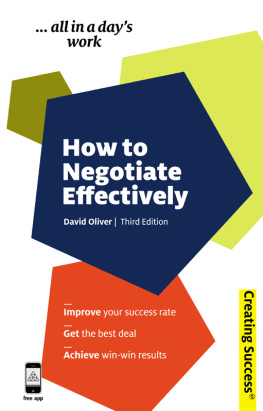Russell Korobkin - The Five Tool Negotiator: The Complete Guide to Bargaining Success
Here you can read online Russell Korobkin - The Five Tool Negotiator: The Complete Guide to Bargaining Success full text of the book (entire story) in english for free. Download pdf and epub, get meaning, cover and reviews about this ebook. year: 2021, publisher: Liveright, genre: Home and family. Description of the work, (preface) as well as reviews are available. Best literature library LitArk.com created for fans of good reading and offers a wide selection of genres:
Romance novel
Science fiction
Adventure
Detective
Science
History
Home and family
Prose
Art
Politics
Computer
Non-fiction
Religion
Business
Children
Humor
Choose a favorite category and find really read worthwhile books. Enjoy immersion in the world of imagination, feel the emotions of the characters or learn something new for yourself, make an fascinating discovery.
- Book:The Five Tool Negotiator: The Complete Guide to Bargaining Success
- Author:
- Publisher:Liveright
- Genre:
- Year:2021
- Rating:3 / 5
- Favourites:Add to favourites
- Your mark:
The Five Tool Negotiator: The Complete Guide to Bargaining Success: summary, description and annotation
We offer to read an annotation, description, summary or preface (depends on what the author of the book "The Five Tool Negotiator: The Complete Guide to Bargaining Success" wrote himself). If you haven't found the necessary information about the book — write in the comments, we will try to find it.
A must-read for lawyers, business people, and other professionals wanting helpful negotiation advice. ?Robert Mnookin, author of Bargaining with the Devil: When to Negotiate, When to Fight
As social creatures, we are always trying to influence each other. Russell Korobkins book lays out five techniques that anyone can use to ensure you get what you want and leave enough on the table so others win, too. The book moves quickly, is full of examples, and provides step-by-step actionable instructions to help you negotiate anything. Everyone needs this book. ?Paul J. Zak, author of Trust Factor: The Science of Creating High-Performance Companies
From leading negotiation expert Russell Korobkin comes this revelatory guide that distills the keys to bargaining into five simple-yet-sophisticated tools that anyone can master.
The Five Tool Negotiator stands apart in a category saturated with breezy, self-help volumes as a compulsively readable and highly researched must-have for anyone looking to improve their bargaining skills. Nationally renowned UCLA law professor Russell Korobkin distills insights drawn from his decades of studying and teaching the keys to successful negotiations into five simple-yet-sophisticated strategies: Bargaining Zone Analysis * Persuasion * Deal Design * Power * and Fairness Norms.Incorporating lively anecdotes and fascinating social science experiments, Korobkin brings to life concepts from the disparate fields of psychology, economics, and game theory. Designed for use at both the flea market and in the C-suite, this game-changing, universal approach provides a formula that a savvy reader can implement immediately:
Tool #1, Bargaining Zone Analysis, enables you to identify the range of agreements that will benefit both parties.
Tool #2, Persuasion, convinces your counterpart that reaching an agreement will benefit them more than they otherwise would have recognized, making them willing to give you more.
Tool #3, Deal Design, structures the agreement in ways that increase its value to both parties.
Tool #4, Power, forces your counterpart to agree to terms relatively more desirable to you.
Tool #5, Fairness Norms, enables you to seal a bargain that both parties can feel good about.
From negotiating the price of a used car to closing a multimillion-dollar merger, Korobkin meticulously explains how to answer the following questions that arise in every negotiation: Should you make the first offer or let the other side go first? What makes some proposals seem more fair than others? How do you decide whether to accept an offer, reject it, or make a counteroffer? When should you propose an unusual agreement structure? What steps can you take to make a bluff believable?
Readers will come away with a roadmap to becoming a truly complete negotiator, able to understand bargaining as both a strategic and social activity. Intuitively accessible and reassuringly persuasive, The Five Tool Negotiator promises to be a classic in the art of bargaining strategy.
25 charts and diagramsRussell Korobkin: author's other books
Who wrote The Five Tool Negotiator: The Complete Guide to Bargaining Success? Find out the surname, the name of the author of the book and a list of all author's works by series.








